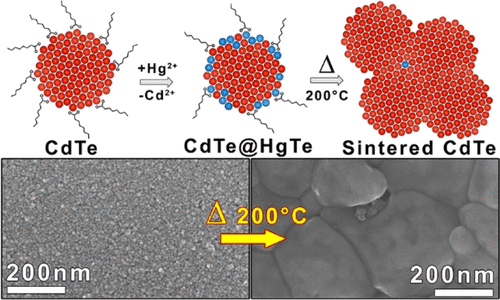当前位置:
X-MOL 学术
›
Chem. Mater.
›
论文详情
Our official English website, www.x-mol.net, welcomes your feedback! (Note: you will need to create a separate account there.)
Metastable CdTe@HgTe Core@Shell Nanostructures Obtained by Partial Cation Exchange Evolve into Sintered CdTe Films Upon Annealing
Chemistry of Materials ( IF 8.6 ) Pub Date : 2020-03-12 , DOI: 10.1021/acs.chemmater.9b05281 Irene Rosina 1, 2 , Beatriz Martín-García 3 , Davide Spirito 4 , Zhiya Dang 1 , Graziella Gariano 1 , Sergio Marras 5 , Mirko Prato 5 , Roman Krahne 4 , Luca De Trizio 1 , Liberato Manna 1
Chemistry of Materials ( IF 8.6 ) Pub Date : 2020-03-12 , DOI: 10.1021/acs.chemmater.9b05281 Irene Rosina 1, 2 , Beatriz Martín-García 3 , Davide Spirito 4 , Zhiya Dang 1 , Graziella Gariano 1 , Sergio Marras 5 , Mirko Prato 5 , Roman Krahne 4 , Luca De Trizio 1 , Liberato Manna 1
Affiliation

|
Partial Hg2+ → Cd2+ cation exchange (CE) reactions were exploited to transform colloidal CdTe nanocrystals (NCs, 4–6 nm in size) into CdTe@HgTe core@shell nanostructures. This was achieved by working under a slow CE rate, which limited the exchange to the surface of the CdTe NCs. In such nanostructures, when annealed at mild temperatures (as low as 200 °C), the HgTe shell sublimated or melted and the NCs sintered together, with the concomitant desorption of their surface ligands. At the end of this process, the annealed samples consisted of ligand-free CdTe sintered films containing an amount of Hg2+ that was much lower than that of the starting CdTe@HgTe NCs. For example, the CdTe@HgTe NCs that initially contained 10% of Hg2+, after being annealed at 200 °C were transformed to CdTe sintered films containing only traces of Hg2+ (less than 1%). This procedure was then used to fabricate a proof-of-concept CdTe-based photodetector exhibiting a photoresponse of up to 0.5 A/W and a detectivity of ca. 9 × 104 Jones under blue light illumination. Our strategy suggests that CE protocols might be exploited to lower the overall costs of production of CdTe thin films employed in photovoltaic technology, which are currently fabricated at high temperatures (above 350 °C), using post-process ligand-stripping steps.
中文翻译:

通过部分阳离子交换获得的亚稳态CdTe @ HgTe核@壳纳米结构在退火后演变成烧结的CdTe薄膜。
利用部分Hg 2 + →Cd 2+阳离子交换(CE)反应将胶体CdTe纳米晶体(NC,尺寸为4–6 nm)转变为CdTe @ HgTe核@壳纳米结构。这是通过在较低的CE速率下工作实现的,该速率限制了CdTe NCs表面的交换。在这样的纳米结构中,当在温和的温度(低至200°C)下退火时,HgTe壳会升华或熔化,并且NC烧结在一起,同时伴随其表面配体的脱附。在此过程结束时,退火后的样品由不含配体的CdTe烧结膜组成,该膜的Hg 2+含量远低于起始CdTe @ HgTe NCs。例如,最初包含10%Hg 2+的CdTe @ HgTe NC在200°C退火后,将其转变为仅含有痕量Hg 2+(小于1%)的CdTe烧结膜。然后使用该程序制造概念验证的基于CdTe的光电检测器,该检测器显示出高达0.5 A / W的光响应和约200的检测率。9×10 4琼斯在蓝光下照明。我们的策略表明,可以利用CE协议降低光伏技术中使用的CdTe薄膜的总体生产成本,该工艺目前是在高温(高于350°C)下使用后处理配体剥离步骤制造的。
更新日期:2020-03-12
中文翻译:

通过部分阳离子交换获得的亚稳态CdTe @ HgTe核@壳纳米结构在退火后演变成烧结的CdTe薄膜。
利用部分Hg 2 + →Cd 2+阳离子交换(CE)反应将胶体CdTe纳米晶体(NC,尺寸为4–6 nm)转变为CdTe @ HgTe核@壳纳米结构。这是通过在较低的CE速率下工作实现的,该速率限制了CdTe NCs表面的交换。在这样的纳米结构中,当在温和的温度(低至200°C)下退火时,HgTe壳会升华或熔化,并且NC烧结在一起,同时伴随其表面配体的脱附。在此过程结束时,退火后的样品由不含配体的CdTe烧结膜组成,该膜的Hg 2+含量远低于起始CdTe @ HgTe NCs。例如,最初包含10%Hg 2+的CdTe @ HgTe NC在200°C退火后,将其转变为仅含有痕量Hg 2+(小于1%)的CdTe烧结膜。然后使用该程序制造概念验证的基于CdTe的光电检测器,该检测器显示出高达0.5 A / W的光响应和约200的检测率。9×10 4琼斯在蓝光下照明。我们的策略表明,可以利用CE协议降低光伏技术中使用的CdTe薄膜的总体生产成本,该工艺目前是在高温(高于350°C)下使用后处理配体剥离步骤制造的。


























 京公网安备 11010802027423号
京公网安备 11010802027423号